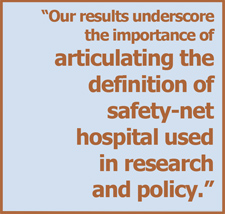Access to the full article is available at: http://mcr.sagepub.com/cgi/content/abstract/1077558709334895v1
Synopsis
The quality of care at safety-net hospitals—which serve many poor, publicly insured, and uninsured patients—varies depending on the criteria used to identify such hospitals, this study finds. Using three different, commonly used classification methods, the researchers came up with three very different sets of results. Public or teaching hospitals had lower performance scores on four "process of care" measures than did private, nonteaching hospitals, but results were mixed for safety-net hospitals identified by the level of uncompensated care they provide.
The Issue
 Several recent studies suggest that safety-net hospitals, particularly those with a large Medicaid caseload, provide lower-quality care and are slower to improve over time than non–safety-net hospitals. But the absence of a common definition for safety-net hospitals presents a challenge to monitoring quality and improving outcomes at hospitals that serve vulnerable patients. This study compared the performance scores of hospitals classified as safety-net providers based on three different criteria: providing a high volume of uncompensated care, having a high percentage of Medicaid-insured patients, or being a public or teaching hospital.
Several recent studies suggest that safety-net hospitals, particularly those with a large Medicaid caseload, provide lower-quality care and are slower to improve over time than non–safety-net hospitals. But the absence of a common definition for safety-net hospitals presents a challenge to monitoring quality and improving outcomes at hospitals that serve vulnerable patients. This study compared the performance scores of hospitals classified as safety-net providers based on three different criteria: providing a high volume of uncompensated care, having a high percentage of Medicaid-insured patients, or being a public or teaching hospital.
Key Findings
- There was little overlap between safety-net hospitals in the three safety-net classifications used in the study. Only 2 percent of safety-net hospitals met all three criteria—high volume of uncompensated care, high Medicaid caseload, and public/teaching hospital.
- Safety-net hospitals with a large Medicaid caseload had significantly lower performance scores for treating pneumonia and preventing surgical infection compared with non–safety-net hospitals.
- Safety-net hospitals that provide more uncompensated care than other hospitals in the community outperformed non–safety-net hospitals in all four care processes studied (those for pneumonia and prevention of surgical infection, as well as for acute myocardial infarction and heart failure). Those facilities having a high ratio of uncompensated care to total expenses—but not a larger share of the community’s uncompensated care—underperformed non–safety-net hospitals.
Addressing the Problem
The study's findings are consistent with previous research showing that hospitals with a large Medicaid caseload perform worse than hospitals that do not, highlighting the need for further investigation of the quality of care provided to Medicaid beneficiaries. But the findings also point to the importance of "carefully considering the criteria used to identify safety-net hospitals," say the authors, who add that researchers should clearly state their methods for identifying safety-net hospitals and describe the implications of those methods. A standardized definition for a safety-net hospital might include a combination of the three approaches used in this study—for example, a hospital that meets a threshold for Medicaid and uninsured patients served and that has certain facility characteristics.
About the Study
The authors analyzed responses from 4,554 participants in the 2006 American Hospital Association Survey. Safety-net hospitals were identified by their volume of uncompensated care, their Medicaid caseload, or their facility status (public or teaching hospital). Safety-net hospitals with a high ratio of uncompensated care to total expenses were designated "high-burden" providers, while "high-market" providers provided more uncompensated care relative to other hospitals. "Core" safety-net hospitals met both criteria for uncompensated care. The authors used 2008 Hospital Quality Alliance Scores to measure performance on four process-of-care measures, including treatment of acute myocardial infarction, heart failure, and pneumonia, and prevention of surgical infection.
The Bottom Line
It is too simplistic to conclude that safety-net providers perform worse or better than non–safety-net providers. Findings vary depending on how safety-net hospitals are defined.


